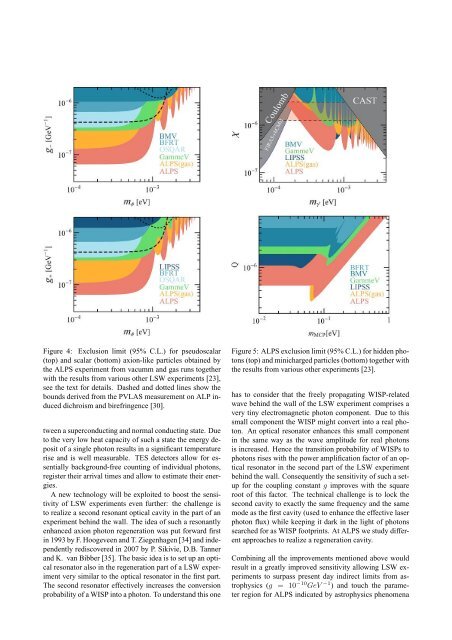Proceedings of International Conference on Physics in ... - KEK
Proceedings of International Conference on Physics in ... - KEK
Proceedings of International Conference on Physics in ... - KEK
You also want an ePaper? Increase the reach of your titles
YUMPU automatically turns print PDFs into web optimized ePapers that Google loves.
Figure 4: Exclusi<strong>on</strong> limit (95% C.L.) for pseudoscalar<br />
(top) and scalar (bottom) axi<strong>on</strong>-like particles obta<strong>in</strong>ed by<br />
the ALPS experiment from vacumm and gas runs together<br />
with the results from various other LSW experiments [23],<br />
see the text for details. Dashed and dotted l<strong>in</strong>es show the<br />
bounds derived from the PVLAS measurement <strong>on</strong> ALP <strong>in</strong>duced<br />
dichroism and birefr<strong>in</strong>gence [30].<br />
tween a superc<strong>on</strong>duct<strong>in</strong>g and normal c<strong>on</strong>duct<strong>in</strong>g state. Due<br />
to the very low heat capacity <str<strong>on</strong>g>of</str<strong>on</strong>g> such a state the energy deposit<br />
<str<strong>on</strong>g>of</str<strong>on</strong>g> a s<strong>in</strong>gle phot<strong>on</strong> results <strong>in</strong> a significant temperature<br />
rise and is well measurable. TES detectors allow for essentially<br />
background-free count<strong>in</strong>g <str<strong>on</strong>g>of</str<strong>on</strong>g> <strong>in</strong>dividual phot<strong>on</strong>s,<br />
register their arrival times and allow to estimate their energies.<br />
A new technology will be exploited to boost the sensitivity<br />
<str<strong>on</strong>g>of</str<strong>on</strong>g> LSW experiments even further: the challenge is<br />
to realize a sec<strong>on</strong>d res<strong>on</strong>ant optical cavity <strong>in</strong> the part <str<strong>on</strong>g>of</str<strong>on</strong>g> an<br />
experiment beh<strong>in</strong>d the wall. The idea <str<strong>on</strong>g>of</str<strong>on</strong>g> such a res<strong>on</strong>antly<br />
enhanced axi<strong>on</strong> phot<strong>on</strong> regenerati<strong>on</strong> was put forward first<br />
<strong>in</strong> 1993 by F. Hoogeveen and T. Ziegenhagen [34] and <strong>in</strong>dependently<br />
rediscovered <strong>in</strong> 2007 by P. Sikivie, D.B. Tanner<br />
and K. van Bibber [35]. The basic idea is to set up an optical<br />
res<strong>on</strong>ator also <strong>in</strong> the regenerati<strong>on</strong> part <str<strong>on</strong>g>of</str<strong>on</strong>g> a LSW experiment<br />
very similar to the optical res<strong>on</strong>ator <strong>in</strong> the first part.<br />
The sec<strong>on</strong>d res<strong>on</strong>ator effectively <strong>in</strong>creases the c<strong>on</strong>versi<strong>on</strong><br />
probability <str<strong>on</strong>g>of</str<strong>on</strong>g> a WISP <strong>in</strong>to a phot<strong>on</strong>. To understand this <strong>on</strong>e<br />
Figure 5: ALPS exclusi<strong>on</strong> limit (95% C.L.) for hidden phot<strong>on</strong>s<br />
(top) and m<strong>in</strong>icharged particles (bottom) together with<br />
the results from various other experiments [23].<br />
has to c<strong>on</strong>sider that the freely propagat<strong>in</strong>g WISP-related<br />
wave beh<strong>in</strong>d the wall <str<strong>on</strong>g>of</str<strong>on</strong>g> the LSW experiment comprises a<br />
very t<strong>in</strong>y electromagnetic phot<strong>on</strong> comp<strong>on</strong>ent. Due to this<br />
small comp<strong>on</strong>ent the WISP might c<strong>on</strong>vert <strong>in</strong>to a real phot<strong>on</strong>.<br />
An optical res<strong>on</strong>ator enhances this small comp<strong>on</strong>ent<br />
<strong>in</strong> the same way as the wave amplitude for real phot<strong>on</strong>s<br />
is <strong>in</strong>creased. Hence the transiti<strong>on</strong> probability <str<strong>on</strong>g>of</str<strong>on</strong>g> WISPs to<br />
phot<strong>on</strong>s rises with the power amplificati<strong>on</strong> factor <str<strong>on</strong>g>of</str<strong>on</strong>g> an optical<br />
res<strong>on</strong>ator <strong>in</strong> the sec<strong>on</strong>d part <str<strong>on</strong>g>of</str<strong>on</strong>g> the LSW experiment<br />
beh<strong>in</strong>d the wall. C<strong>on</strong>sequently the sensitivity <str<strong>on</strong>g>of</str<strong>on</strong>g> such a setup<br />
for the coupl<strong>in</strong>g c<strong>on</strong>stant g improves with the square<br />
root <str<strong>on</strong>g>of</str<strong>on</strong>g> this factor. The technical challenge is to lock the<br />
sec<strong>on</strong>d cavity to exactly the same frequency and the same<br />
mode as the first cavity (used to enhance the effective laser<br />
phot<strong>on</strong> flux) while keep<strong>in</strong>g it dark <strong>in</strong> the light <str<strong>on</strong>g>of</str<strong>on</strong>g> phot<strong>on</strong>s<br />
searched for as WISP footpr<strong>in</strong>ts. At ALPS we study different<br />
approaches to realize a regenerati<strong>on</strong> cavity.<br />
Comb<strong>in</strong><strong>in</strong>g all the improvements menti<strong>on</strong>ed above would<br />
result <strong>in</strong> a greatly improved sensitivity allow<strong>in</strong>g LSW experiments<br />
to surpass present day <strong>in</strong>direct limits from astrophysics<br />
(g = 10 −10 GeV −1 ) and touch the parameter<br />
regi<strong>on</strong> for ALPS <strong>in</strong>dicated by astrophysics phenomena













